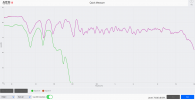I posted both with the original target curve, that is, without any post calibration adjustments, and also posted those with post calibration adjustments that obviously would alter the target curves. I posted them on different threads and several times so I don't know which is which anymore.
The one that shows the without adjustments to with adjustments (that is, deep bass and room gain), is like the one below, that I posted a couple times before but repeat here for convenience.
The black curve is the one after adding deep bass, and reduced room gain, the red one was when I had the Denon AVR, so that's with Audyssey:
As I said many time, I was disappointed that so few people, even Audio Advice and Audioholics didn't emphasize the need for serious users to use REW (or equivalent) and the ARCG app to get proper bass response.
ARCG is, at least in my case, failed to achieve "flat bass" per the default curve, but created major dips/suck outs (noted in my green curve). So they don't even make "flat response", but as you mentioned, "neutered bass" is a bad word. Though they didn't do too bad with the mid to lower mid bass, only screwed up the below 50 Hz, that I consider as "deep bass".
Based on my findings, and evidently yours as well, it is highly possible that many, if not most ARCG users may not know what the missed, i.e. the deep bass layer. Surely they may get great sound quality, depending on their speakers/rooms characteristics, but they could have done much better if they don't blindly trust internet hearsay, and ARCG's marketing and technical articles narratives.
View attachment 286325

